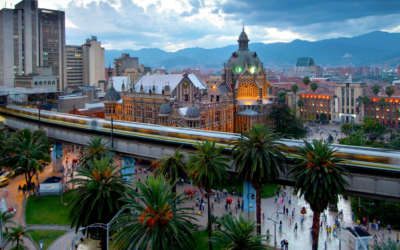This article was written with the input of Dr. Ronald St. John, epidemiologist, former Federal Manager of the Response to SARS epidemic in Canada, former Director General Centre for Emergency Preparedness and Response, and creator of the Global Public Health Information Network – the world’s first digital disease detection system.
Managing Travel Risks
There will always be risks and unexpected changes that can happen in any trip. With infectious diseases, the risk for the individual traveller depends a lot on what they do, where they go, and how they manage their risk when they get to their destination.
Examples of Risk
Switzerland is home to a little known condition known as tick borne encephalitis, which you can catch from a tick. Your risk will be highly dependent upon if you’re hiking or camping where you can be exposed to ticks. If you stay in Geneva, your risk will basically be zero.
Another example for those who travel to Thailand. If you head to Bangkok, your risk for malaria is low; however, if you venture out into the jungle, then your risk is much larger.
In short, what you do makes a difference.
Covid-19
Covid-19 is a little different than the previous examples for a couple of reasons.
- It is a respiratory disease, it passes person to person.
- It is now present everywhere except perhaps remote islands. Your risk is generally higher because it is so abundant.
Covid-19 can be acquired anywhere. Being near people and in crowded spaces increases your risk. Going through airports, transiting with public transport, checking into accommodations, all have their own risks and different levels of interaction with people.
Since Covid-19 is easily transmittable, for your own safety and for the safety of others, wearing a mask is recommended. Sanitizing and washing your hands frequently is also highly recommended. Establishments have increased their social distancing measures and sanitization policies as well.
If you spend your time hopping into different pubs, going to see crowded tourist attractions, going on public transport, you will have a higher risk than those who do not participate in those activities. If you spend time sight seeing in your own car, stay in your own room, spend time in larger, uncrowded outdoors spaces, then you will have done a good job minimizing your exposure and risk of contracting COVID-19.
How you behave in your daily life, what you do while in transit, and what you do when you get to a destination affects your risk.
Entry Requirements
Alongside managing health risks, travellers must be aware of a country’s entry requirements. Depending on their nationality, origin of travel, and reason for travel, they may not be allowed to travel to certain countries. Prior to arranging plans, travellers must seek this information and be aware of entry measures.
Entry measures have been put into place by many countries in order to minimize the spread of Covid-19. Some new measures include:
– Signing health declaration forms
– Having a negative Covid-19 certificate prior to arriving that was completed within a certain time frame
– Taking a Covid-19 test upon arrival
– Quarantining for a certain amount a time at a government facility or home isolation
– Downloading a health tracking mobile app to your phone
Changing Travel Restrictions
Another issue travellers need to be weary of are changing conditions and travel restrictions in their desired destinations.
Many governments are creating new behavioural policies to control the spread of Covid-19, such as implementing curfews. Government policies can change suddenly or with little notice. These changes can happen within countries’ travel policies (entry/exit restrictions), quarantine requirements, and the opening or closure of airports. Even citizens/residents are not always exempt from restrictions and may not be allowed to leave their country.
Countries may implement country-wide policies that apply to the operation of accomodations, non-essential shops, restaurants, places of worship, and more. It is important for travellers to have an idea of what they can still do in their destination.
It can be time-consuming and difficult for travellers to find up to date and accurate information – all the time. A Sitata Plus subscription is a great app for travellers to find out the entry requirements of their destination, what is open, and what they can do. We notify travellers when a situation changes so they will never be caught off guard.
Travel Restrictions Examples
There can be different travel bubbles. Some countries may allow citizens of certain countries to enter regardless of where they are coming from, whereas some countries allow foreign nationals to enter but only from certain countries. There are also different entry requirements created for arrivals.
An example to consider is England. They were allowing nationals to exit the country and had a green list. The green list referred to countries that if you were arriving from them you would not need to quarantine. Thislist constantly changes following the rates in various countries. If infections went above the allowed thresholds, countries would be taken off the list and travellers who were there would then need to incur the two week quarantine even if originally they were not going to need to. Portugal and Croatia are two countries popular for British tourists and had been on the green list. Over a couple of weeks their infection rates went up and consequentially, everyone returning from there would now need to quarantine if arriving after a certain time and date.
People have other commitments and intentions when returning from a trip and many do not want to incur an extra two weeks out of work or be stuck at home. People scrambled to get back before the start date causing the price of airline tickets to go up, some people couldn’t get seats, and the change in policy forced people to adapt to new plans.
Be Prepared
If travellers are considering travelling, they should take these risks into consideration.
You run the risk of acquiring the disease and bringing it home to family and friends. You run the risk of getting stuck somewhere or no longer meeting entry requirements and your return home may all of a sudden impose a quarantine on you.
Be aware of changing conditions and understand how you can minimize your risks while travelling.
Sitata’s app has all the information you need for when you travel; including travel restrictions and entry requirements.



